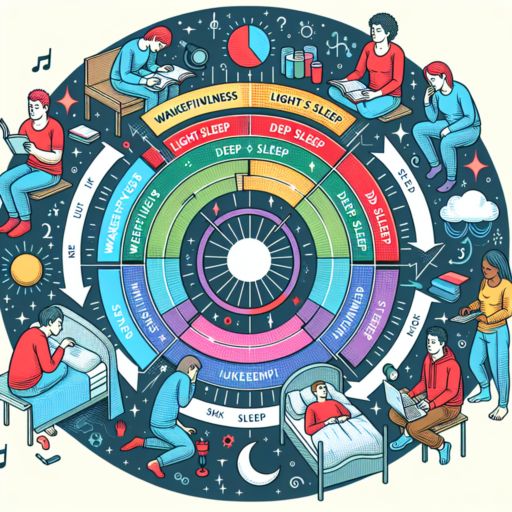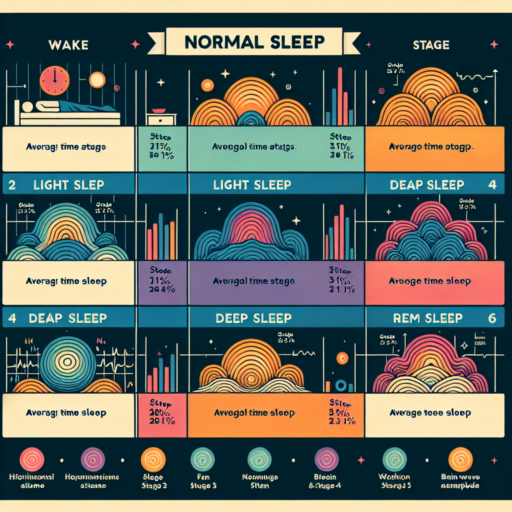Understanding the Basics of the Sleep Cycle
Understanding the basics of the sleep cycle is essential for grasping how our bodies manage rest and rejuvenation. The sleep cycle consists of several stages, each contributing uniquely to our physical and mental health. Knowing these stages can help optimize sleep quality, enhancing overall well-being.
Stages of the Sleep Cycle
At the core of the sleep cycle are two primary types: Rapid Eye Movement (REM) and Non-REM (NREM) sleep. NREM sleep is further divided into three stages, gradually deepening from light sleep to deep sleep. The cycle begins with NREM Stage 1, transitioning into deeper stages, and eventually, into REM sleep. This cycle repeats several times throughout the night, with REM periods becoming longer towards the morning.
NREM sleep, particularly the deeper stages, plays a critical role in physical recovery and growth, as it’s during these periods that the body repairs muscles, grows tissue, and strengthens the immune system. Conversely, REM sleep is where most dreaming occurs and is thought to be crucial for memory consolidation, learning, and emotional processing. Understanding these distinctions is key to grasifying why both deep sleep and REM are vital for holistic health.
Each sleep cycle lasts approximately 90 to 120 minutes, with an average adult going through four to six cycles per night. The proportion of REM to NREM sleep changes with each cycle, affecting how rested you feel in the morning. Hence, disruptions to these cycles, whether through stress, lifestyle, or health conditions, can significantly impact sleep quality and, by extension, daily functioning and health.
The Stages of Sleep: From Light to Deep Sleep
Understanding the stages of sleep is crucial in recognizing the quality of rest we get each night. Sleep is not just a single, uniform block of time where the body shuts off; rather, it’s a complex process that cycles through various phases, each serving an important role in our overall health and well-being.
NREM (Non-Rapid Eye Movement) Sleep
The journey through the night begins with NREM sleep, which is further divided into three stages. Stage 1 is the lightest phase of sleep, often considered the transition period between wakefulness and sleep. It’s during this stage that you can be easily awakened. Moving deeper, Stage 2 acts as a preparatory phase for deep sleep, where the body starts to disengage from its surroundings, heartbeat and breathing slow down, and body temperature drops. The final segment of NREM, Stage 3, is when deep sleep occurs. This phase is critical for physical recovery, tissue repair, and immune function strengthening.
REM (Rapid Eye Movement) Sleep
Following the NREM stages, the sleep cycle culminates with the REM phase, often associated with vivid dreams. The REM stage is characterized by rapid eye movements, increased brain activity, and temporary paralysis of the leg and arm muscles. It’s during REM sleep that the brain consolidates memories, processes emotions, and stimulates learning. This phase becomes longer with each cycle, hence, most of our REM sleep occurs in the second half of the night.
Each cycle through these stages lasts about 90 minutes, with the body cycling through NREM and REM sleep several times throughout the night. Understanding these stages helps in identifying sleep patterns and addressing disturbances, ensuring a restful and rejuvenating night’s sleep.
How Long Is a Complete Sleep Cycle?
Understanding the dynamics of a complete sleep cycle is crucial for enhancing overall sleep quality. A typical sleep cycle lasts about 90 to 110 minutes and encompasses various stages, each contributing differently to the restorative processes our bodies undergo during sleep. This cycle repeats several times throughout the night, with the duration and intensity of each stage varying with each cycle.
The quest to comprehend the length and significance of these cycles is not just academic. It has practical implications for planning sleep schedules and maximizing the restorative power of sleep. A common misconception is that sleep duration is the most important factor, but the quality and the number of complete cycles matter immensely. Adults typically need between 4 to 6 cycles per night, indicating a healthy sleep range of 7 to 9 hours to ensure they are moving through all essential stages.
Each stage within a sleep cycle plays a vital role, from the light sleep stages that prepare our bodies to enter deeper rest, to the deep sleep stage that is crucial for physical recovery, and finally, the REM stage, which supports brain functions such as memory consolidation. Recognizing the importance of completing multiple cycles can guide habits that promote more restful and effective sleep.
REM Sleep: The Dream Phase Explained
REM sleep, standing for Rapid Eye Movement sleep, is a unique and vital phase of the sleep cycle known for its association with vivid dreaming. During this stage, the brain becomes more active, simulating wakefulness in many ways, whereas the body experiences atonia, a temporary paralysis of the muscles, preventing the person from acting out dreams.
One of the distinguishing features of REM sleep is its impact on memory consolidation. Studies suggest that this phase plays a crucial role in processing and integrating memories, particularly those related to emotional and procedural tasks. This aspect of REM sleep supports cognitive functions such as learning, problem-solving, and emotional regulation.
Another interesting facet of REM sleep is its distribution throughout the night. The sleep cycle comprises multiple stages, starting from light sleep to deep sleep before entering REM. Initially brief, REM periods become longer towards the morning, with a full cycle repeating roughly every 90 to 120 minutes. This pattern points to the importance of a full night’s sleep for experiencing adequate REM phases, crucial for mental and emotional health.
Understanding REM sleep’s characteristics and significance can shed light on various sleep disorders, including REM sleep behavior disorder (RBD) and narcolepsy. RBD, for instance, involves the lack of muscle atonia, leading to the physical acting out of dreams, which can be both violent and dangerous. This highlights the complex and essential nature of REM sleep within our sleep cycles and overall health regimen.
Why the Sleep Cycle Is Important for Your Health
Understanding the reason behind the critical nature of the sleep cycle for your health is paramount. The human body relies heavily on a sophisticated internal clock known as the circadian rhythm, which influences your sleepiness and wakefulness throughout a 24-hour period. This rhythm dictates your body’s need for restorative sleep, crucial for physical health, mental health, and overall well-being.
Diving deeper into the importance of the sleep cycle, it involves various stages, including REM (Rapid Eye Movement) and non-REM sleep, each playing a unique role in body recovery and brain function. The sleep cycle promotes the repair of tissues, strengthens the immune system, and enhances memory consolidation, emphasizing its significant impact on health and cognitive performance. Missing out on these critical phases can lead to numerous negative health outcomes, including increased stress levels, impaired cognitive function, and various chronic conditions.
Moreover, it’s not just the quantity but the quality of sleep that plays a crucial role in health maintenance. Regulating your sleep cycle helps stabilize mood, reduce stress, and increase energy levels, demonstrating how intertwined sleep is with nearly every aspect of physical and mental health. As the science of sleep continues to evolve, the clear message that emerges is the undeniable link between a consistent, quality sleep cycle and the attainment of optimal health. Emphasizing proper sleep hygiene can thus be one of the most direct and impactful ways to enhance your overall health and vitality.
How to Track Your Sleep Cycle for Better Rest
Understanding and tracking your sleep cycle is a powerful step towards achieving better rest. With the advancements in technology, it has become easier to monitor sleep patterns and make necessary adjustments for improved sleep quality. In this context, it’s important to focus on the methods and tools that can aid in this process.
Using Sleep Tracking Devices
One of the most effective ways to track your sleep cycle is through the use of sleep tracking devices. These gadgets, ranging from wearable watches to under-the-pillow sensors, provide detailed insights into your sleep phases, including how much time you spend in light, deep, and REM sleep. The data collected can help pinpoint disturbances in your sleep cycle and guide you toward strategies for enhancement.
Mobile Apps for Sleep Monitoring
Another convenient method for tracking sleep is by utilizing mobile apps designed for sleep monitoring. These apps often use the accelerometer in your smartphone to detect movement during the night, providing a general estimation of your sleep quality. While they may not be as accurate as dedicated sleep trackers, they offer a good starting point for people interested in understanding their sleep patterns.
By observing and analyzing your sleep cycle, you can identify irregularities and take steps to address them. Whether it’s adjusting your bedtime routine or creating a more conducive sleep environment, the insights gained from tracking your sleep can lead to significant improvements in your overall health and well-being. Remember, the key to better rest lies in not just the quantity of sleep, but the quality of it as well.
Factors That Can Disrupt Your Sleep Cycle
Sleep is a critical component of our overall health, but various factors can disrupt our sleep cycle, making it difficult to get a good night’s rest. Understanding these disturbances can empower us to take actionable steps toward improving our sleep patterns. Here we will explore the most common disruptors of sleep.
1. Exposure to Electronic Devices
One of the most pervasive culprits in today’s digital age is the excessive exposure to blue light from electronic devices. Screens from smartphones, tablets, and computers emit a significant amount of blue light, which can interfere with the production of melatonin, the hormone responsible for regulating our sleep-wake cycle. Limiting screen time at least an hour before bed and using blue light filters can help mitigate this effect.
2. Irregular Sleep Schedules
Our bodies thrive on consistency, especially when it comes to sleep. An irregular sleep schedule can throw off our body’s internal clock, making it challenging to fall asleep and wake up at desired times. Endeavor to maintain a regular bedtime and wake-up schedule, even on weekends, to promote a more balanced sleep cycle.
3. Caffeine and Alcohol Consumption
Caffeine and alcohol are two substances that can significantly impact the quality of our sleep. Caffeine is a known stimulant that can keep you awake and disrupt your sleep if consumed late in the day. Meanwhile, alcohol may initially aid in falling asleep but it reduces the quality of sleep by interrupting the REM cycle. Moderating the intake of both, particularly in the hours leading up to bedtime, can be beneficial.
Tips for Optimizing Your Sleep Cycle Naturally
Optimizing your sleep cycle naturally can significantly enhance your overall health and well-being. In today’s fast-paced world, many find it challenging to maintain a consistent sleeping pattern, leading to a range of health issues. However, by adopting a few natural strategies, you can improve your sleep quality and wake up feeling refreshed and energized.
Establish a Relaxing Pre-Sleep Routine
Creating a calming pre-sleep routine is paramount in signaling your body it’s time to wind down. Consider practices such as reading a book, indulging in a warm bath, or practicing meditation to ease your transition into sleep. Implementing these activities consistently each night can help regulate your internal body clock and prepare your mind and body for rest.
Maintain a Consistent Sleep Schedule
Adhering to a regular sleep schedule, even on weekends, can greatly enhance the quality of your sleep. By going to bed and waking up at the same time each day, you foster a healthy sleep-wake cycle, allowing your body to adjust and optimize its internal rhythm. This consistency aids in falling asleep faster and enjoying a more restorative sleep.
Optimize Your Sleep Environment
Your sleeping environment plays a crucial role in how well you sleep. Ensuring your bedroom is conducive to sleep involves several factors, such as maintaining a comfortable temperature, minimizing noise, and reducing light exposure. Using blackout curtains and adjusting the thermostat can create an ideal sleep setting, enabling a natural sleep cycle.
The Impact of Technology on Your Sleep Cycle
The correlation between technology usage and the disruption of our sleep patterns is becoming an area of increasing concern. With the proliferation of smartphones, tablets, and other electronic devices, the way we wind down and prepare for sleep has drastically changed. Studies have shown that exposure to blue light emitted by screens can significantly affect our natural sleep cycle, known as the circadian rhythm, leading to difficulties in falling asleep and overall poorer sleep quality.
Interference with Melatonin Production
One of the primary ways technology affects our sleep is through its impact on melatonin production. Melatonin is a hormone responsible for regulating sleep-wake cycles, and its production is influenced by exposure to light. The blue light from screens can suppress melatonin levels more than any other form of light, making it harder to fall asleep and stay asleep. This disruption is particularly concerning in the evenings, when melatonin levels are naturally rising in anticipation of bedtime.
Overstimulation of the Brain
Beyond the physical impact of blue light, engaging with technology before bed can also overstimulate the brain. Activities such as checking email, scrolling through social media, or playing video games can increase alertness and make it significantly harder to relax and transition into sleep. The content consumed can further exacerbate this effect, with exciting or stressful material potentially leading to increased heart rates and a sense of alertness that counteracts sleep readiness.
No se han encontrado productos.
Understanding Sleep Disorders and the Sleep Cycle
Sleep plays a fundamental role in our overall health and well-being, yet many people struggle with various sleep disorders that negatively affect the quality of their slumber. Sleep disorders can range from common problems such as insomnia and sleep apnea to less common conditions like narcolepsy and restless legs syndrome. Understanding these disorders and how they impact the sleep cycle is crucial for finding effective treatment options and improving sleep quality.
The sleep cycle consists of several stages, including REM (rapid eye movement) sleep and several stages of non-REM sleep, each playing a vital role in our body’s restoration and health. Disturbances in these cycles can lead to significant health issues, both mentally and physically. For instance, sleep deprivation caused by sleep disorders can impair cognitive functions, emotional stability, and even cardiovascular health.
Effective management and treatment of sleep disorders begin with recognizing the symptoms and understanding their impact on the sleep cycle. Common symptoms include difficulty falling asleep, frequent awakenings during the night, excessive daytime sleepiness, and snoring accompanied by pauses in breathing. These symptoms can significantly disrupt the natural flow of the sleep cycle, preventing the body from going through the important stages of repair and regeneration that occur during sleep.




